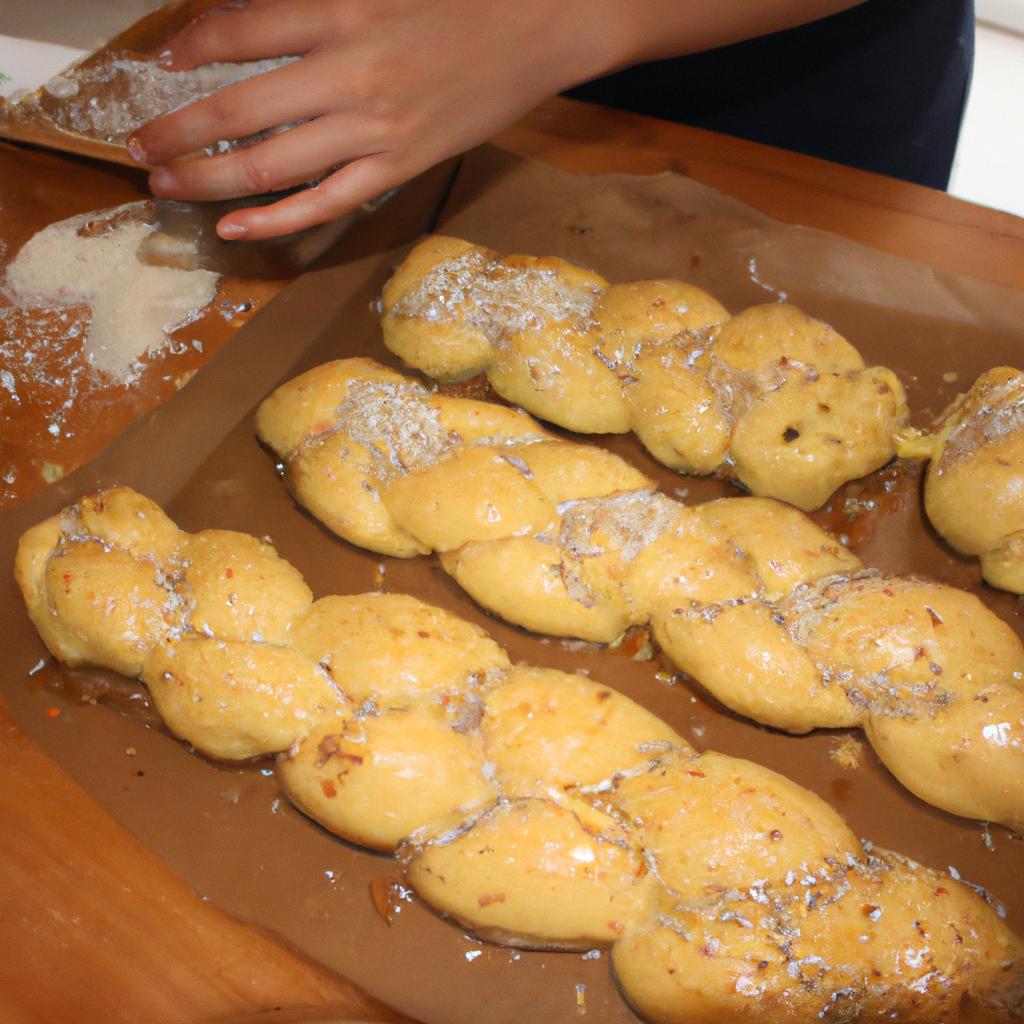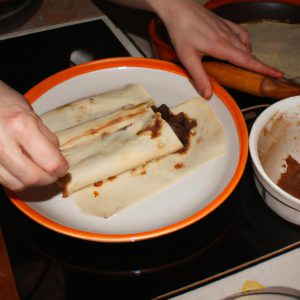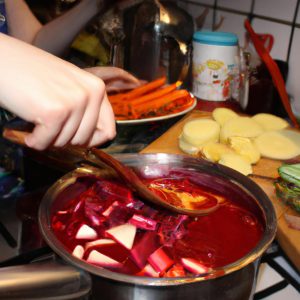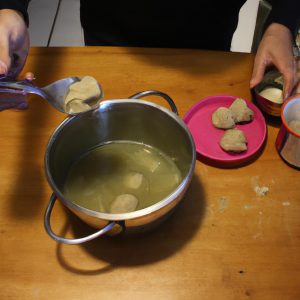Challah: Ashkenazi Heritage & Food

Challah, a staple in Ashkenazi Jewish cuisine, holds significant cultural and religious significance. With its rich history and unique preparation methods, challah serves as an embodiment of the Ashkenazi heritage and tradition. This article delves into the origins of challah, explores its symbolic importance in Jewish rituals, and highlights its distinct characteristics that have made it a beloved culinary icon.
To illustrate the profound connection between challah and Ashkenazi culture, let us consider a hypothetical scenario. Imagine Sarah, a third-generation Ashkenazi Jew living in New York City, preparing for her weekly Shabbat dinner. As she meticulously braids the dough with utmost precision and care, she is not only following an age-old recipe passed down through generations but also honoring her ancestors’ traditions. The aroma of freshly baked challah fills her kitchen, evoking memories of family gatherings and festive occasions from years gone by. In this instance, Sarah’s act of making challah becomes more than just a culinary endeavor; it transforms into a tangible expression of her heritage and devotion to preserving Ashkenazi customs.
Throughout this article, we will explore the historical roots of challah within the context of the diverse Ashkenazi community. We will delve into the symbolism behind each braid of the challah loaf and its representation of unity and interconnectedness. Additionally, we will discuss the ritual of separating a portion of dough, known as “hafrashat challah,” which symbolizes the act of giving back and acknowledging the blessings bestowed upon us.
Furthermore, we will examine the unique characteristics that set challah apart from other types of bread. From its soft and fluffy texture to its slightly sweet taste, challah is distinctively rich and indulgent. Its golden crust, achieved through an egg wash before baking, adds an extra touch of elegance to this already beloved bread.
Moreover, we will explore how challah has evolved over time, adapting to different geographical regions and cultural influences. From traditional round loaves for Rosh Hashanah’s symbolic meaning of cyclical renewal to braided loaves shaped into circles or crowns during weddings and holidays like Purim, challah continues to evolve while maintaining its significant role in Jewish rituals.
Lastly, we will discuss how challah has transcended religious boundaries and become a popular staple in many households worldwide. Its versatility makes it suitable for various occasions beyond just Shabbat dinners—whether enjoyed plain or with various toppings or fillings such as sesame seeds or raisins.
By understanding the historical context, symbolism, unique characteristics, cultural adaptations, and widespread appeal of challah within Ashkenazi Jewish cuisine, one can truly appreciate this culinary icon’s significance as a representation of tradition, heritage, and connection.
History of Challah
Challah, a traditional Jewish bread, has a rich history that dates back centuries. To understand its significance in Ashkenazi heritage and food culture, it is important to explore the origins and evolution of this beloved bread.
One fascinating example showcasing the historical importance of challah is found in medieval Europe. During this time period, Jewish communities faced many challenges, including legal restrictions on their dietary practices. In response to these limitations, observant Jews developed unique ways to sustain their religious traditions while conforming to external regulations. One such adaptation was the shaping of challah into intricate braided loaves resembling non-religious shapes commonly consumed by the surrounding population. This allowed Jews to maintain their cultural identity through an essential aspect of their cuisine while adhering to restrictive laws.
- Nourishment: Challah represents more than just sustenance; it symbolizes warmth and nourishment within Jewish households.
- Community: The act of baking and sharing challah fosters a sense of community among friends and family members who come together for Shabbat or holiday meals.
- Tradition: As generations pass down recipes and techniques for making challah, it becomes both a link to ancestors’ customs and a way for individuals to connect with their heritage.
- Ritual: The ritualistic nature of separating and setting aside a portion of dough as “challah” during the baking process adds depth and spirituality to the act itself.
Moreover, exploring the history of challah reveals interesting insights when presented in table format:
| Time Period | Key Development | Impact |
|---|---|---|
| Medieval Europe | Adaptation of challah shape to navigate dietary restrictions | Preservation of cultural identity |
| Early Modern Era | Introduction of sweet variations | Incorporation into festive occasions |
| Immigration Wave | Challah becomes a symbol of Jewish identity in new lands | Reinforcement of cultural ties within diaspora |
| Contemporary Era | Creative reinterpretations and fusion with local flavors | Expression of culinary innovation and diversity |
Challah’s historical significance extends beyond religious practice; it is interwoven into the fabric of Ashkenazi culture. This bread not only nourishes the body but also strengthens bonds between individuals, preserves traditions, and serves as a marker of collective identity. Understanding the history behind challah provides valuable insights into its enduring place within Jewish communities.
Transitioning to the subsequent section on the Significance of Challah in Ashkenazi Culture, we delve deeper into how this cherished bread continues to shape contemporary customs and rituals.
Significance of Challah in Ashkenazi Culture
Imagine a Jewish family gathering around the Shabbat table, eagerly anticipating the fragrant aroma of freshly baked challah. This traditional braided bread has deep roots in Ashkenazi heritage and holds significant cultural significance. Over time, challah has evolved both in its preparation techniques and symbolic meanings.
Historically, challah was made from simple ingredients like flour, water, yeast, salt, and sugar. However, as Jewish communities migrated across different regions, varying customs influenced the evolution of this beloved bread. For instance, Eastern European Jews introduced unique additions such as raisins or honey to enhance the flavor profile of their challah. This regional diversity resulted in numerous variations of challah recipes being passed down through generations.
The prominence of challah within Ashkenazi culture can be attributed to several factors:
-
Ritualistic Symbolism:
- Challah represents unity and community bonds during Shabbat meals.
- Its braided shape symbolizes intertwining connections between individuals.
- Sharing challah with others symbolizes generosity and hospitality.
-
Spiritual Significance:
- Through the act of separating a small portion of dough known as “hafrashat challah,” baking challah becomes an expression of gratitude towards God’s provision.
- The process involves reciting blessings that reinforce religious values and connect individuals to their faith.
-
Nostalgic Associations:
- Baking and consuming challah evoke fond memories for many Ashkenazi Jews, reminding them of their grandparents’ kitchens or childhood experiences.
- It serves as a tangible link to ancestral traditions and cultural identity.
-
Communal Bonding:
- Preparing challah often becomes a communal activity involving multiple generations coming together in the kitchen.
- These shared moments foster connection and preserve familial ties.
In summary, the evolution of challah within Ashkenazi culture showcases the unique blend of tradition, spirituality, and community that this bread embodies. Its significance extends beyond a mere food item, serving as a symbol of unity, faith, and cultural heritage. As we delve deeper into the world of challah, let us now explore the various ingredients used in its preparation.
Now, let us examine the diverse array of ingredients that contribute to the distinct flavors and textures found in different types of challah.
Ingredients used in Challah
Challah holds a significant place in the culinary and cultural traditions of Ashkenazi Jews. This unique braided bread is not only a staple at Shabbat dinners, but it also serves as an important symbol of Jewish heritage and faith. The tradition of baking challah has been passed down through generations, preserving both the taste and meaning behind this beloved dish.
To understand the importance of challah in Ashkenazi culture, let’s consider a hypothetical scenario. Imagine a family coming together for their weekly Shabbat dinner. As they gather around the table, the aroma of freshly baked challah fills the air, creating an atmosphere of warmth and togetherness. Each member takes part in breaking off a piece from the loaf, reciting blessings before enjoying this sacred food. In this way, challah becomes more than just sustenance; it becomes a tangible expression of religious observance and familial connection.
The significance of challah can be further understood by exploring its historical roots and symbolism within Jewish culture. Here are some key aspects:
- Spiritual Symbolism: The act of separating a portion (known as “hafrashat challah”) during the baking process represents offering gratitude to God and acknowledging His role as provider.
- Unity and Community: Sharing challah with loved ones fosters a sense of unity among families and communities.
- Time-Honored Traditions: Baking challah according to traditional recipes creates continuity with past generations and preserves cultural practices.
- Festive Celebrations: On special occasions like holidays or lifecycle events, intricately shaped challot often take center stage on festive tables, adding beauty to these joyous moments.
To emphasize the emotional impact that challah carries, imagine sitting at one end of your dining table adorned with delicious foods for Shabbat dinner. Atop lies a beautifully braided golden brown challah, radiating warmth and tradition. The bullet points below capture some of the emotions that this sight may evoke:
- Nostalgia: Reminding you of cherished memories with family and loved ones.
- Comfort: Offering a taste of home and familiarity in an ever-changing world.
- Belonging: Instilling a sense of belonging to a rich cultural heritage.
- Gratitude: Inspiring appreciation for the blessings in life, both big and small.
Furthermore, consider a table that displays the various types of challah enjoyed around the world. This three-column, four-row table showcases just how diverse and culturally significant challah can be:
| Country/Region | Challah Name | Description |
|---|---|---|
| Israel | Yerushalmi Challah | Sweetened with honey or sugar, often topped with sesame seeds |
| Morocco | Dibbs-Eddad (Moroccan) | Made with traditional Moroccan spices like aniseed or fennel |
| Argentina | Rosca de Pascua | A sweet braided bread typically consumed during Easter season |
| Poland | Kugelhopf | Rich yeast cake filled with raisins, nuts, and rum-soaked dried fruit |
In conclusion, challah holds deep significance within Ashkenazi culture. Beyond its role as nourishment, it serves as a tangible link between Jewish traditions and generations past. Its spiritual symbolism, ability to foster unity, adherence to time-honored practices, and presence at festive celebrations make challah much more than just a loaf of bread. As we delve into the next section on traditional challah baking techniques, let us explore the methods by which this beloved dish is brought to life through skilled hands and heartfelt dedication.
Traditional Challah Baking Techniques
Imagine a Jewish family gathering around the table on Friday evening, ready to celebrate Shabbat. The aroma of freshly baked challah fills the air, inviting everyone to partake in this beloved Ashkenazi tradition. But have you ever wondered why certain ingredients are used to make challah? In this section, we will explore the significance behind these ingredients and their role in preserving Ashkenazi heritage.
One essential ingredient found in traditional challah recipes is eggs. Eggs symbolize fertility, new beginnings, and sustenance. They also represent renewal and hope for future generations—a testament to the resilience of the Jewish people throughout history. Incorporated into the dough, eggs enrich its texture and provide a golden hue that signifies prosperity.
Another key ingredient that gives challah its distinct flavor is honey. Honey acts as a sweetener while imparting a subtle richness to the bread. It serves as a reminder of both nature’s bounty and the sweetness of life itself. Just as bees work together harmoniously to produce honey, so too does challah bring families closer through shared traditions and moments of celebration.
To further deepen our understanding of the sentimental value attached to challah ingredients, let us reflect upon four emotional connections evoked by these components:
- Nostalgia: Reminiscing about childhood memories spent baking or enjoying warm slices of homemade challah.
- Comfort: Finding solace in familiar flavors that evoke feelings of warmth and security.
- Unity: Strengthening familial bonds by engaging in time-honored rituals and sharing meals together.
- Continuity: Preserving cultural heritage by passing down cherished recipes from one generation to another.
Additionally, consider the following table which highlights some common ingredients found in traditional challah recipes:
| Ingredient | Symbolism |
|---|---|
| Eggs | Fertility & Renewal |
| Honey | Nature’s Bounty & Sweetness |
| Flour | Nourishment & Sustenance |
| Salt | Preservation & Purification |
With these ingredients and their symbolic meanings in mind, we can appreciate the deeper significance behind each element that goes into making challah. As we delve further into the traditions surrounding this iconic bread, let us now explore the symbolism of challah in Jewish customs and rituals.
Symbolism of Challah in Jewish Traditions
Section Title: The Influence of Challah on Jewish Culinary Practices
As we delve deeper into the world of challah, it becomes evident that this traditional bread holds a significant place in Jewish culinary practices. Its preparation techniques, symbolism, and cultural significance vary across different communities, adding to its richness and diversity. To illustrate this point further, let us consider the case study of an Ashkenazi family living in New York City.
Challah’s Impact on Culinary Traditions:
The influence of challah extends beyond being a simple loaf of bread consumed during Shabbat meals. It has become intertwined with Jewish traditions and serves as a symbol of unity and spirituality within the community. To better understand the impact of challah on Jewish culinary practices, several key aspects come into play:
- Ritual Significance: Challah baking is often seen as a sacred act deeply rooted in religious observance. As families gather around their kitchen tables to prepare this braided delicacy, they engage in age-old rituals that have been passed down through generations.
- Community Connection: Baking challah fosters a sense of camaraderie among individuals within the community. Whether participating in communal bake-offs or sharing recipes online, these experiences create bonds that extend far beyond mere food consumption.
- Cultural Preservation: Through the practice of making challah according to traditional techniques, communities are able to preserve their unique heritage for future generations.
- Emotional Nourishment: The process of kneading dough, shaping intricate braids, and smelling the aroma wafting from the oven can evoke feelings of comfort, nostalgia, and joy – emotions that are deeply ingrained within Jewish culture.
To emphasize the emotional connection people have with challah, consider the following table illustrating how this humble bread affects our senses:
| SENSE | EXPERIENCE |
|---|---|
| Sight | Golden-brown crust glistening |
| Smell | Warm, yeasty aroma |
| Touch | Soft and pillowy texture |
| Taste | Sweetness with a hint of honey |
The influence of challah on Jewish culinary practices cannot be overstated. From its role as a religious symbol to the emotional nourishment it provides, this bread holds immense significance within the community. In the following section, we will explore the various regional variations of challah found in different Jewish communities. Through these adaptations, we witness how challah continues to evolve while remaining an integral part of Jewish culture.
Next Section: Variations of Challah in Different Communities
Variations of Challah in Different Communities
In the previous section, we discussed the rich symbolism that challah holds in Jewish traditions. Now, let us explore the various variations of challah found in different communities and how they contribute to the diverse tapestry of Ashkenazi heritage.
One prominent variation of challah is known as “water challah.” This unique type of bread is made by replacing some or all of the liquid ingredients with water instead of milk. Water challah has its roots in Eastern European Jewish communities where dairy products were scarce and expensive. By using water instead of milk, these communities ensured that everyone could partake in this sacred bread without any restrictions.
As we delve deeper into the world of challah, it becomes evident that each community brings its own flavor and character to this cherished bread. Let’s take a closer look at some notable variations:
-
Raisin Challah: Often enjoyed during festive occasions such as holidays or special family gatherings, raisin challah adds a touch of sweetness to this already delicious bread. The plump raisins provide bursts of flavor in every bite, making it an instant favorite among those who appreciate a hint of natural sweetness.
-
Sesame Seed Challah: With its distinct nutty flavor and crunchy texture, sesame seed challah stands out for its unique taste profile. The beautiful arrangement of toasted sesame seeds on top gives this loaf an appealing visual appeal, making it a popular choice for Shabbat dinners and other significant celebrations.
-
Whole Wheat Challah: For those seeking a healthier alternative without compromising on taste, whole wheat challah offers a nutritious option. Made with whole wheat flour instead of refined white flour, this variation provides additional fiber and nutrients while still maintaining the beloved softness characteristic of traditional challah.
-
Chocolate Chip Challah: Combining two beloved treats – chocolate chips and fresh-baked bread – chocolate chip challah is a delightful indulgence. This variation adds an element of surprise and decadence to the classic bread, making it particularly appealing to younger generations who appreciate modern twists on traditional dishes.
To further illustrate the wide range of challah variations, let us consider the following table:
| Challah Variation | Flavor Profile | Occasions |
|---|---|---|
| Raisin | Sweet | Holidays |
| Sesame Seed | Nutty | Shabbat |
| Whole Wheat | Nutritious | Everyday |
| Chocolate Chip | Indulgent | Desserts |
As we conclude our discussion on the variations of challah in different communities, it becomes evident that this humble bread has evolved over time while retaining its central role in Jewish traditions. The diverse flavors and styles reflect the unique cultural backgrounds and regional influences within Ashkenazi heritage. Whether enjoyed during religious ceremonies or as part of everyday meals, challah continues to symbolize unity, tradition, and connection with one’s roots.



